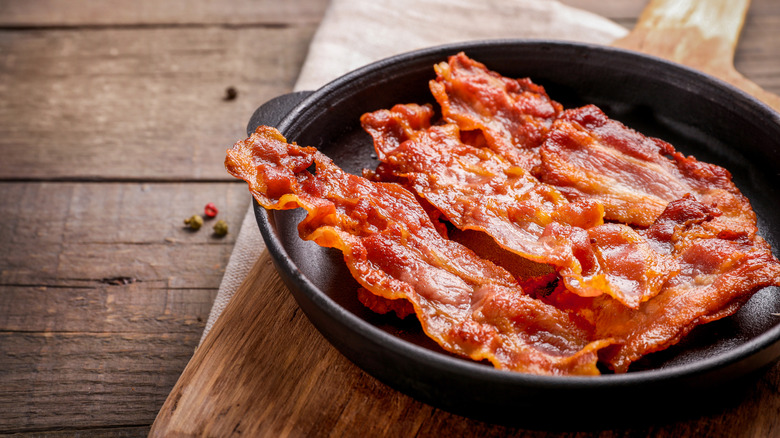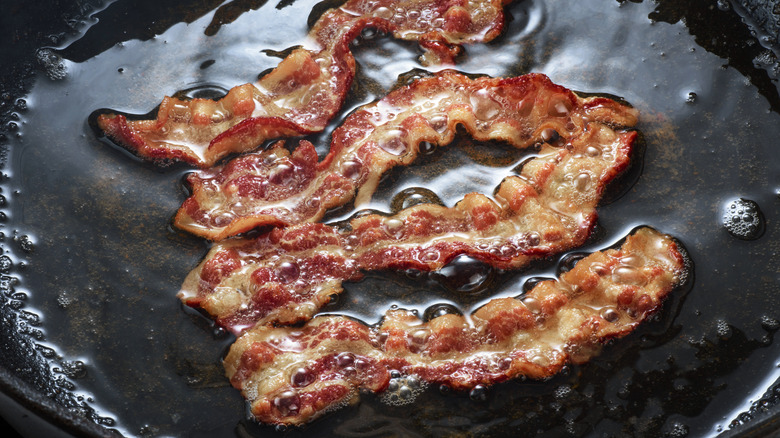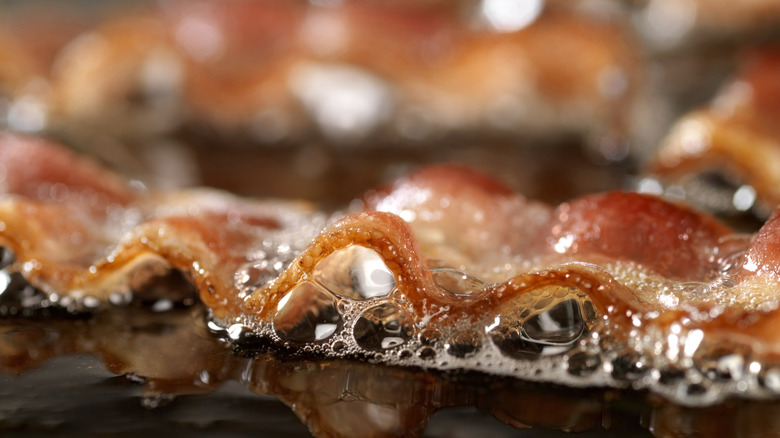The Water Hack That Yields The Crispiest Bacon Results
Limp, floppy bacon can still be tasty, but let's be honest, crispy bacon tends to be much more satisfying. The most common way to make bacon crispy is to simply let it sit on the stove for longer rather than taking it off the heat as soon as the meat is done cooking. With this method, the bacon gets crispy, however, it usually shrinks in size. This is due to the fact that the longer you cook the meat, the tighter its proteins become.
You might assume therefore that excessive shrinkage is an inevitable side effect of cooking crispy bacon, but as it turns out, you can easily avoid it by introducing water to the cooking process. Not only does the addition of water shorten the required cooking time, which in turn leaves you with normal-sized pieces of bacon, but it also produces a texture that's even crispier than if you were to fry it the traditional way.
How to cook bacon in water
Cooking meat in water typically implies boiling it in a pot, but the process is a bit different for bacon, at least if you want it to become crispy. Start by arranging bacon in a cold frying pan, then pour in enough water to cover all the strips, but not so much that they're completely submerged. Then, crank up the heat to medium high. During this initial cooking phase, the water will gradually reduce, and when it's completely evaporated out of the pan, lower the temperature to medium.
Once the water is gone, the cooking process will start to feel familiar. You can fry up your bacon as you normally would, flipping the strips as necessary. The bacon won't need as much time to crisp up, so just make sure to keep your eye on it so it doesn't burn. Once you finally get to take a bite of your bacon, you'll be surprised at how much crispier it is.
Why water yields the crispiest bacon
The idea that water would make bacon crispier probably sounds odd, especially considering when cooking other meats like steak, you're told to pat the meat dry for better browning. When it comes to bacon on the other hand, water isn't just there to cook the meat, it's there to keep the heat of the pan from fluctuating and rising too high.
This is important because fat takes longer to render than meat takes to cook. Normally, if you wait for the fat to fully render and crisp up, the meat of your bacon will burn. That means when you cook bacon the traditional way, you have to take it off the stove before the fat reaches its crispiest, or else you'll be left with burnt bacon. Because water keeps the temperature of the pan low and steady, it gives the bacon fat enough time to properly render. By the time the water has evaporated out, the fat should be completely rendered and will then be able to crisp up at the same rate as the meat. Since you don't have to worry about the meat burning before the fat finishes rendering, the bacon can reach its crispiest potential without shrinking more than necessary.
It's a bit counter-intuitive, but most importantly for you, it means you can achieve bacon that's super crispy from head to toe — the meat and the fat – that's perfect for a big breakfast, BLT sandwiches, or crumbling on top of any number of dishes.


